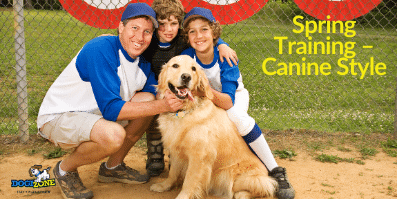Spring Training for Dogs
Dog spring training, what? Spring training is usually associated with professional baseball. It is a time of year for players to get back in shape and to review old skills and strategies, and maybe even learn something new.

However, dog spring training is not that much different. It is a time for owners to transition their pets from couch canines to more active dogs in a safe and healthy manner. Dogs, particularly adult and senior dogs, need time to slowly adjust to a more active lifestyle, especially if they have been indoors and relatively inactive over the cold winter months.
The key to spring training for your dog is to take it slow and make it progressive in nature. Think of the way that humans build up to doing a long hike or running a 5K. They start out with short interval types of training that gradually progress to longer periods of more intensive exercise.
This type of gradual training is also important for a dog, and it is critical for a dog that may be overweight or obese. Suddenly providing lots of outdoor time can result in muscle stiffness and pain for the dog, which limits their ability to get out and exercise for the next few days. Not only does this set your training program back, but it may also result in muscle strains and sprains, or even more serious issues with tendons, ligaments, and muscles that require length healing time or surgery to treat.
Consider Your Dog
Most dog owners have a good idea of how much exercise their dogs get in a day. However, this is usually not concentrated into a continuous block of exercise.
Start with a short 15 to 20-minute walk at a moderate pace. Start out slow and gradually pick up the pace to the desired level. Monitor your dog for signs of excessive panting, signs of any type of limb stiffness or pain, or other signs of fatigue. Keep the dog moving but not jogging or running to keep up. Ideally, walk your dog on grass or soil surfaces as hard concrete can be very hard on joints and your dog’s feet.
It is also important to think about puppies and juvenile dogs with regards to an exercise ramp up in the spring. The large breeds and giant breeds of dogs need to have limited intensive exercise during their growth stages, and it is critical to talk to your vet if you are planning on jogging or running with these puppies and juvenile dogs.
Gradually increase the intensity and the duration of the exercise to match how your dog is responding. If older dogs seem stiff or sore after your exercise session, step down the intensity. Only increase when the dog is no longer experiencing stiffness and pain.
Keep in mind, playing in the backyard, time at the dog park with other canines, and just enjoying a stroll in the evening with the family are all great ways to add more exercise for your dog in the spring and throughout the summer months.

